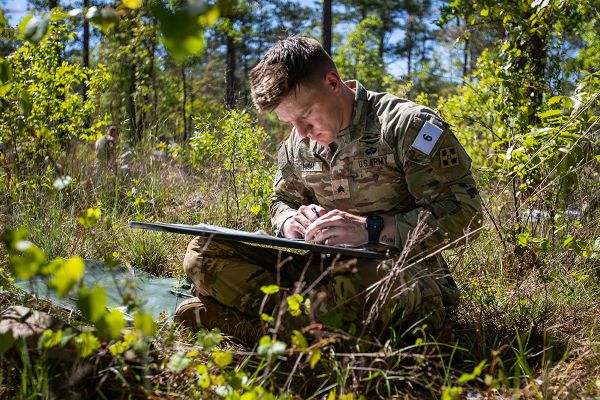
Ft. Benning, Georgia. (April 10, 2023): In this photo by Captain Alex Werden, Sergeant Austin High from 2nd Squadron, 1st Cavalry Regiment, 1st Stryker Brigade Combat Team, 4th Infantry Division uses a map and protractor to determine the distance between two plotted points during Best Mortar Competition at the “Home of Infantry”. Despite recent technologies like GPS, mortar crews continue to use the tried-and-true methods of a generation ago. The soldiers are tested on their ability to calculate the distance between their position and the target and then determine the elevation necessary to shoot their mortar rounds accurately.
Officially called Indirect Fire Infantrymen, they are a member of a mortar squad, section or platoon and are often the difference between life or death on the battlefield. Today’s mortar teams can trace their lineage to 1413 Korea where the first mortar was used in marine combat, the wan'gu (gourd-shaped mortar).Today’s indirect fire weapons are based upon the Stokes mortar, a portable version designed in 1915 by British weapons designer F.W.C. Stokes that became a prime allied weapon during World War I.
The Stokes mortar weighed just over a hundred pounds and could fire up to twenty-two rounds per minute with a range of up to 3,600 feet. Most modern mortar systems consist of four main components: a barrel, a base plate, a bipod, and a sight. The modern mortar is a muzzle-loaded weapon and is relatively simple to operate. It consists of a barrel into which the gunners drop a mortar round and, when the round reaches the base, it hits a fixed firing pin that fires the round.
Ammunition for mortars generally comes in two main varieties: fin-stabilized and spin-stabilized and both types can be either illumination (infrared or visible illumination), smoke, high explosive, or training rounds. Mortar bombs are often referred to, incorrectly, as "mortars". Today’s indirect fire squads employ three types of mortars with varying ranges and power (60mm, 81mm, and 120mm rounds).
To become an Indirect Fire Infantrymen, students must complete Basic Training and a 12-week advanced infantry course at Fort Benning, Georgia to learn their trade. Fort Benning is home to the U.S. Army Infantry School, the Armor School, the 75th Ranger Regimental Headquarters, and many other operational and training units.


